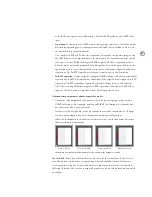
85
Trapping:
Sets up trapping for workflows involving color separation. The Trapping menu
includes the following options:
•
Off
. Applies no trapping. This setting is automatically applied when composite output is
specified, because trapping is only relevant to color separations.
•
Application Built-In
. Creates traps as separations are output, using the trapping engine
included with InDesign (also known as the on-host trapping option). It does not trap
placed EPS files unless they are Photoshop DCS 1.0-2.0/EPS raster images; Adobe In-RIP
Trapping doesn’t have this limitation. If a document uses stroked TrueType fonts, better
results can be obtained using Adobe In-RIP Trapping or by converting the type to
outlines (select the type and choose Type > Create Outlines).
•
Adobe In-RIP
. Sends color data that can be trapped at the RIP. This option is available
only when In-RIP Separation is selected in the Color menu and the targeted device sup-
ports Adobe In-RIP Trapping.
Note:
The Resolution option available before version 2 of InDesign is not available in
InDesign 2 or later. This option was used to calculate resampling of images. Now, resam-
pling of one-bit images is based on the resolution provided by the Adobe Graphics Manager
(AGM), which is usually obtained from the device PPD. Resampling of grayscale and color
images is now based on the current screen ruling. Note that all resampling is controlled by
the setting of the Send Data option in the Graphics panel of the Print dialog box. In the Send
Data popup menu, the All option does not resample and the other options do.
Flip:
Creates a mirror image of each page for the purpose of producing emulsion that faces
in the desired direction. Flip options are not available for non-PostScript printers and
device-independent PostScript files. The following flip options are available:
•
None
. Doesn’t change the output. This is the default setting.
•
Horizontal
. Reflects pages across the vertical axis; text becomes wrong-reading.
•
Vertical
. Reflects pages across the horizontal axis; text becomes upside-down and wrong-
reading.
•
Horizontal and Vertical
. Reflects pages across both axes. The result is the same as rotat-
ing a page 180 degrees.
Negative:
Inverts the polarity of pages so that black objects are white, and vice versa. Usually
used to produce film negatives. This option is available only for color separation and com-
posite grayscale output. This option uses a setpagedevice method, not a transfer function, so
if your RIP uses custom screens for negative printing, InDesign will use them.






























